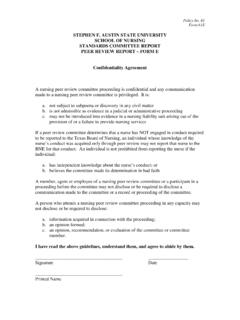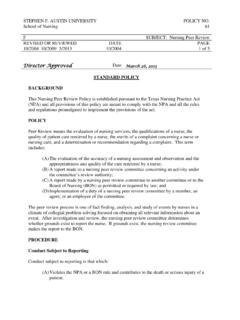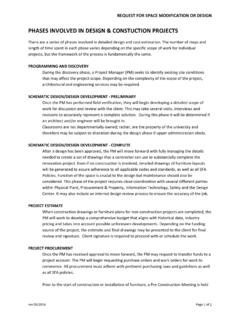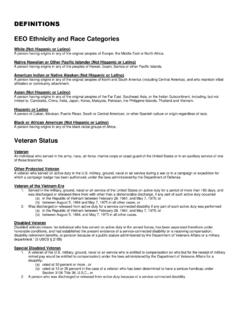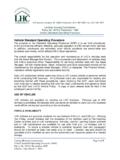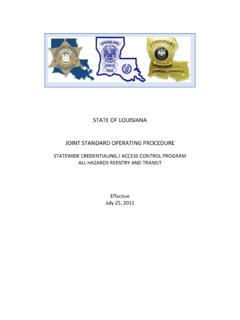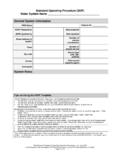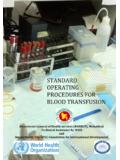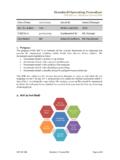Transcription of Decontamination: Standard Operating Procedure
1 decontamination : Standard Operating Procedure This Procedure should be followed in the event of an emergency where a victim or equipment should need to be decontaminated due to a chemical, biological, or radioactive release or spill. When planning to decontaminate in a medical emergency, procedures should be followed to ensure: decontamination of the victim. Protection of medical personnel. Disposing of contaminated protective equipment and wash solutions. The decision whether or not to decontaminate a victim is based on the type and severity of the illness or injury and the nature of the contaminant.
2 For some emergency victims, immediate decontamination may be an essential part of life-saving first aid. For others, decontamination may aggravate the injury or delay life-saving treatment. If decontamination does not interfere with essential treatment, it should be performed. If decontamination can be done: Wash, rinse and/or cut off protective clothing and equipment. If decontamination cannot be done: Wrap the victim in blankets, plastic, or rubber to reduce contamination of other personnel.
3 Alert emergency and offsite medical personnel to potential contamination; instruct them about specific decontamination procedures if necessary. Send along site personnel familiar with the incident. Equipment In an emergency, equipment will be necessary to rescue and treat victims, to protect response personnel, and to mitigate hazardous conditions on site ( , to contain hazardous materials or fight fires). Some regular equipment can double for emergency use. Provide safe and unobstructed access for all firefighting and emergency equipment at all times.
4 Consider adopting the following work procedures . For personnel protective equipment: Basic equipment that should be available at any site can be found in Table A on the next page. Special equipment should be obtained depending on the specific types of emergencies that may occur at a particular site and the capabilities of backup offsite personnel. When determining the type and quantity of special equipment, the following factors should be considered: The types of emergencies that may arise.
5 For each emergency, consider a probable and a worst-case scenario. The types of hazards that site personnel may be exposed to and the appropriate containment, mitigative, and protective measures. The capabilities and estimated response times of offsite emergency personnel. The numbers of site personnel who could be victims during an emergency. The probable number of personnel available for response. Table A Onsite Equipment and Supplies for Emergency Response Personal Protection Medical Hazard Mitigation Blankets Antiseptics Spill-containment equipment such as absorbents and oil Personal protective equipment and clothing specialized for known site hazards.
6 Emergency Eye Wash Containers to hold contaminated materials and clothing. Half face respirators and cartridges Emergency Safety Showers Acid and Base Neutralizers Ice Other clean up gear such as chemical resistant shovels Reference books containing scoops etc. basic first-aid procedures and information on treatment of specific chemical injuries. Stretcher Water in portable containers Persons trained in CPR Medical Treatment/First Aid In emergencies, toxic exposures and hazardous situations that cause injuries and illness will vary from site to site.
7 Medical treatment may range from bandaging of minor cuts and abrasions to life - saving techniques. In many cases, essential medical help may not be immediately available. For this reason, it is vital to train onsite emergency personnel in on-the-spot treatment techniques, to establish and maintain telephone contact with medical experts ( , toxicologists), and to establish liaisons with local hospitals and ambulance services. When designing this program, these essential points should be included: Train personnel in emergency treatment such as first aid and CPR.
8 Training should be thorough, frequently repeated, and geared to site-specific hazards. Establish liaison with local medical personnel, for example: 24-hour-on-call physician, medical service, and poison control center. Inform and educate these personnel about site-specific hazards so that they can be optimally helpful if an emergency occurs. Develop procedures for contacting them; familiarize all on-site emergency personnel with these procedures . Set up onsite emergency first-aid stations; see that they are well supplied and restocked immediately after each emergency.
9 Emergency Response procedures Response operations usually follow a sequence that starts with the notification of trouble and continue through the preparation of equipment and personnel for the next emergency. Notification Alert personnel to the emergency. Sound a site alarm to: Notify personnel. Stop work activities if necessary. Lower background noise in order to speed communication. Begin emergency procedures . Notify on-site emergency response personnel about the emergency and include essential information.
10 * What happened? * Where it happened? * Whom it happened to? * When it happened? * How it happened? * The extent of damage. * What aid is needed? Size Up Available information about the incident and emergency response capabilities should be evaluated. The following information should be determined, to the extent possible: What happened? Type of incident. Cause of incident. Extent of chemical release and transport. Extent of damage to structures, equipment, and terrain. Casualties: 1.
